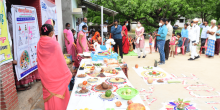Budget outlays for nutrition specific interventions Insights from Bihar Chhattisgarh Odisha and Uttar Pradesh

Background: India’s nutrition and health flagship schemes by design can deliver nationally recommended direct nutrition interventions (DNI) – which can reduce child stunting by one fifth, at 90% coverage. DNI are delivered largely through Centrally Sponsored Schemes (CSS). With recommendations of 14th Finance Commission, the autonomy of India's State governments to prioritize majority of CSS, and introduce state specific schemes, has increased substantially. However, whether DNI are prioritized by states in most recent years' budgets needs to be examined.
Methods: We studied publicly available information on state budget outlays (allocations and expenditures) for a set of DNI included in India’s policy framework for four Indian states – Bihar, Chhattisgarh, Odisha and Uttar Pradesh – housing 45% of stunted children in India. State budget outlays for three financial years (2016-17 (BE), 2015-16 (BE + Supplementary) and 2014-15 (AE)) and ‘Budget Outlay adequacy’ for supplementary nutrition programme delivering three DNI (complementary food for children 6-36 months, supplementary food for pregnant women and breastfeeding mothers and additional food rations for severely malnourished children 6-59 months) against government norms and coverage and for five DNI – IFA and Vit. A supplementation, deworming and Diarrhoea control for children and adolescents, against Menon et. al. (2015) cost estimates was studied.
Results: In last three fiscal years, across studied states - (i) DNI budget was <2% of the total state budget; (ii) it has increased in absolute terms, but declined as a proportion of total state budget from FY 2014-15 to FY 2016- 17 for three states (Uttar Pradesh: 1.8% to 1.3%; Bihar: 1.9% to 1.4%; and Odisha: 1.8% to 1.4%) and been retained at 1.4% for Chhattisgarh between FY 2014-15 and FY 2016-17; (iii) there are significant variations in budget outlays across DNI; major share being of supplementary nutrition programme followed by cash transfers to women (maternity entitlements). On 3 DNI outlay adequacy (FY 2015-16) studied under supplementary nutrition programme, there is outlay gap of 50%, 32%, 22%, and <1% for Odisha, Uttar Pradesh, Bihar, and Chhattisgarh, respectively. On the other 5 DNI analysed against Menon et. al. (2015) estimates, total resource gap of ~75% for Chhattisgarh, ~74% for Bihar, ~73% for Uttar Pradesh and ~66% for Odisha was found.
Conclusion: State DNI budget requires greater prioritisation in all four study states; increases in overall state budgets should lead to at least proportionate increases for DNI budget outlays. The budget outlays for health related DNI need to be stepped up. The budgets allocated should be adequate to meet the resource requirements as per existing norms and stated number of beneficiaries under schemes.


